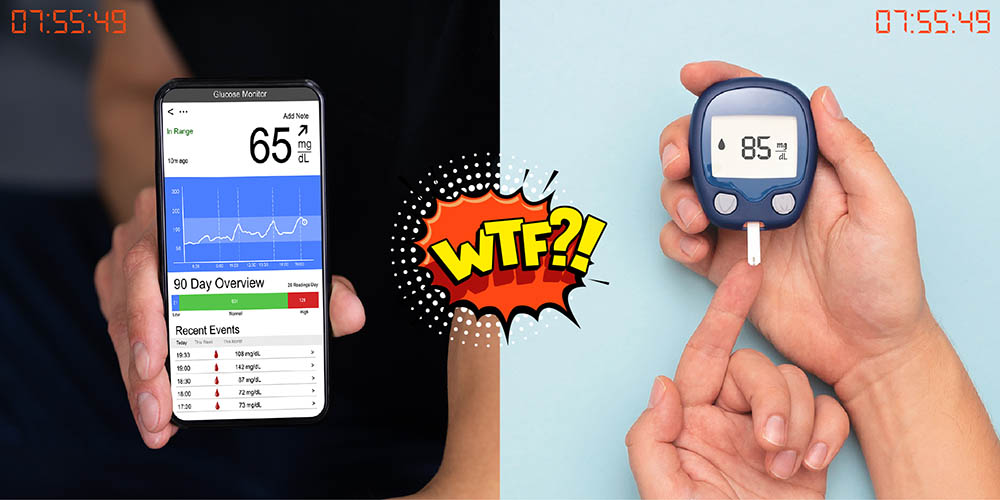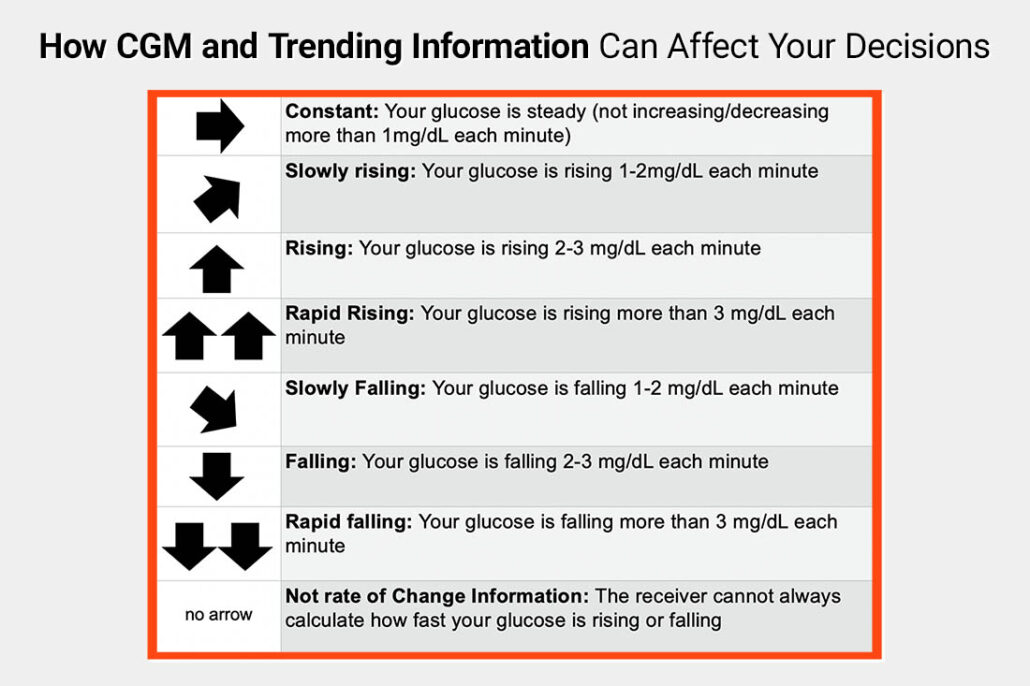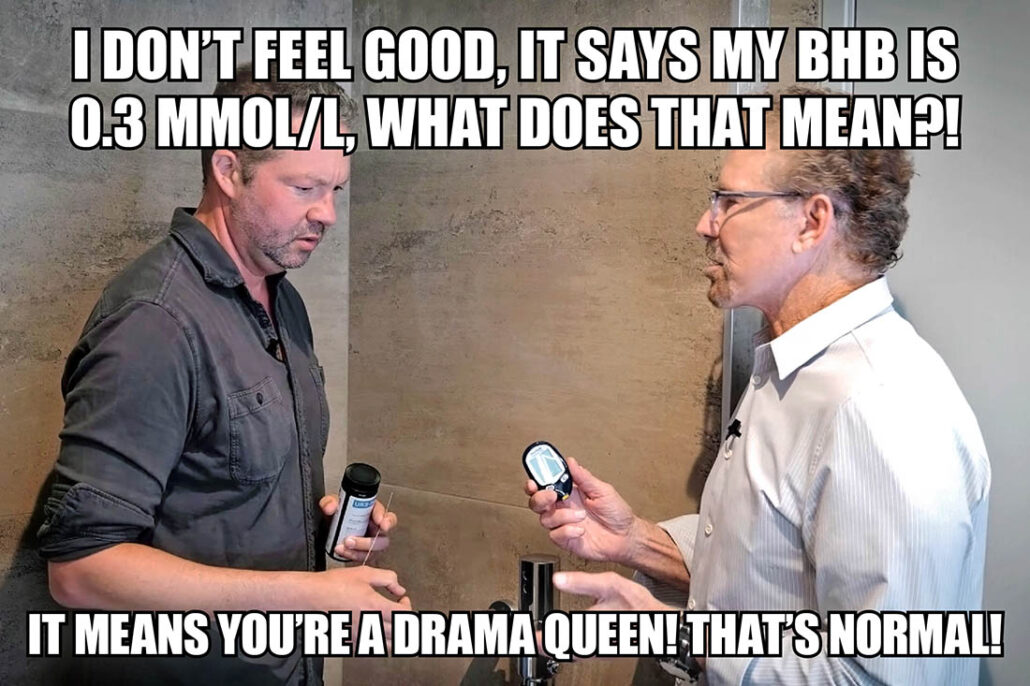
Updated June 17, 2025
- CGMs and fingersticks measure glucose from different sources in your body. CGMs measure from the interstitial fluid that surrounds the cells of the tissues below your skin, and fingersticks measure glucose directly from capillary blood.
- CGMs can lag behind blood glucose by 5-20 minutes (depending on the CGM), especially during rapid changes in blood sugar, such as after you eat or exercise.
- It’s not unusual for CGM and fingerstick values to be different due to factors like lag time, sensor age and placement, and hand cleanliness. Also, if you’re moving the part of the body where your sensor is (if your sensor is on your arm and you’re a baseball pitcher, for example), that can affect it. The safest place is to put your CGM is on your butt, unless you do belly dancing!
Reading Time: 5 minutes
If you wear a CGM, this scenario has probably happened to you. You get a low alert but you don’t feel low, so you blow the dust off your glucose meter and test your blood sugar with a fingerstick. Your CGM value reads 65 mg/dL, but your fingerstick says 85 mg/dL. Which one do you believe? Do you treat the low, or wait?
How accurate are CGMs vs fingersticks? Is there an acceptable variance between the two?
The short answer is yes, but there’s more to the story.
The Importance of Trend Arrows
Knowing the direction your blood sugars are heading is just as important as knowing what your blood sugar numbers are. We can’t emphasize this enough – it’s SO IMPORTANT to look at your CGM trend arrows!!
When a trend arrow is diagonally up, your blood sugar is typically rising at 1-2 mg/dL per minute. One arrow straight up is rising at 2-3 mg/dL per minute, and two arrows up is rising at over 3 mg/dL per minute. So if you do not take the trend arrow into account, you cannot compare the values!
The above scenario where a CGM value reads 65 mg/dL and the fingerstick value says 85 mg/dL is a perfect example of when it looks like the values are way off. However, if the 65 mg/dL value on the CGM had a trend arrow diagonally up or straight up, it might be very accurate.
The chart below shows how you can use trend arrows to determine how quickly your blood glucose is changing.

How Does a CGM Measure Glucose Compared to a Fingerstick?
CGMs and fingersticks measure sugar concentrations from different sources in the body.
Fingersticks measure glucose in the capillary blood, which reflects close to real-time glucose levels (a real-time value is when your blood is drawn at a lab). CGMs use a tiny sensor inserted under the skin to measure glucose levels in the interstitial fluid, which is a thin layer of fluid (not blood) that surrounds the cells of the tissues below your skin.

How Accurate Are CGMs Required to Be Compared to Blood Glucose Meters?
The national standards for CGM accuracy in the United States are largely based on guidelines and performance criteria from the FDA, the International Organization for Standardization (ISO), and professional organizations like the American Diabetes Association.
While there’s no single unified U.S.-specific CGM accuracy standard, CGMs must meet certain international and regulatory benchmarks to be approved and trusted for clinical use.
Most people use the following national standards:
- For glucose values less than 100 mg/dL: the CGM value should be within 15 mg/dL of the blood glucose meter number. For example, if the blood glucose meter number is 90 mg/dL, then the CGM value should be between 75 and 105 mg/dL.
- For glucose values greater than 100 mg/dL: the CGM value should be within 15% of the meter value. For example, if the blood glucose meter value is 180 mg/dL, then the CGM value should be between 153 and 207 mg/dL.
So you really need to control your expectations. Before you complain to your doctor that your values are different, use the above formula and know that based on the ISO national standards, there’s an acceptable degree of error that would not alter clinical decisions.
Is It Normal for CGM and Fingerstick Values to Be Different?
Yes. Once you’re beyond ISO standards, there are additional reasons why CGM and fingerstick values can be different. Besides the difference in how values are measured (capillary blood vs interstitial fluid), other factors can come into play.
CGMs can have variances due to:
- Sensor lag time (see below)
- Sensor placement
- Compression (e.g., lying on the sensor while sleeping)
- Sensor age (the difference in values can be greater during the first 24 hours of a new sensor)
- A defective sensor
- Environmental factors like temperature (check out our article on diabetes device hacks that discusses false highs from heat)
Nothing irks me more than when CGM and fingerstick numbers are way off, especially when I’m getting automatic insulin delivery. If I’m wearing an AID system and the sensor number is falsely high (due to a hot bath, for example), I’m going to get inappropriate insulin delivery that could cause a low blood sugar.
Fingerstick accuracy can be affected by:
- Hand cleanliness (were your hands clean and dry before you tested?)
- Insufficient blood sample
- Test strip quality (were the strips exposed to air for an extended period, or were they expired?)
- Environmental factors like temperature
CGM Accuracy and Sensor Lag Time
Interstitial fluid lags behind blood glucose by about 5 to 20 minutes (depending on the CGM), and it can be even more pronounced if your blood sugar is rising or falling quickly (like after you eat or during exercise). A CGM may show a lower value during a rise or a higher value during a drop compared to a fingerstick.
For example, after eating a high-carb meal, fingerstick glucose might read 180 mg/dL, while the CGM could still show 150 mg/dL. This isn’t a malfunction — it’s simply the interstitial fluid “catching up” to the blood glucose.
It’s more dangerous when your blood sugars are dropping rapidly. Your CGM may say 70 mg/dL, but you could really be 55 mg/dL depending on your trend arrows – whether you have one arrow down, two arrows down, or a diagonal arrow down.

So Which One is “Right”?
As I often say…it’s like adult diapers. It Depends.
Fingerstick readings are typically considered the gold standard for real-time blood glucose and are generally used for dosing decisions in situations where your symptoms don’t match your CGM value.
CGMs, while slightly lagged, provide a broader picture of glucose patterns and trends. As we mentioned earlier, one of the key advantages of CGMs are the trend arrows, which provides context beyond a single number at a single moment in time.
How to Dose Insulin When Blood Sugar Values Don’t Match
If your CGM and fingerstick values are significantly different and you’re worried about the correct insulin dose to give, err on the side of caution and use the blood glucose value that calls for the lower dose of insulin.
The Benefits of CGM for People with Type 2 Diabetes
CGMs can help you learn how lifestyle factors like food, meal timing, exercise, sleep, stress, and alcohol can impact blood sugar. They’re an invaluable tool for anyone living with any type of diabetes.
In a recent study, CGM use in people with type 2 diabetes resulted in a larger reduction in A1c and improved time in range.
Currently you need to be on at least one shot of insulin per day for CGMs to be covered by insurance or Medicare, but we hope that requirement will change soon.
Dexcom and Abbott recently developed CGMs specifically for people with type 2 diabetes who are not on insulin. Dexcom’s Stelo is available to purchase online without a prescription, and Abbott’s Rio should be coming out soon. For information on Stelo CGM costs, visit Stelo.com.
Frequently Asked Questions
🩸 CGM vs Fingerstick Accuracy: Which Reading Should I Trust More
Generally speaking you can trust both, but fingersticks are typically considered the most accurate for your current blood sugar level. So if you feel “off” or your symptoms don’t match your CGM value, double-check with a fingerstick.
❌ If CGMs and Fingerstick Values Can Be So Different, How Can You Tell When a CGM Sensor Failed
If your fingersticks are really far off from your CGM sensor after doing several finger pricks over the span of three to four hours, then you have a bad sensor. FreeStyle Libre CGMs can’t be calibrated, but if you have a Dexcom and you try calibrating it several times and you still get crazy numbers (or no trend arrows) it’s a bad sensor. Call the CGM company to get a replacement – don’t complain to your doctor!
🧐 Which CGM Is the Most Accurate?
CGMs in the U.S. include the FreeStyle Libre 3 Plus, Dexcom G7, Eversense 365, and Medtronic MiniMed 780G (with Guardian 4 or Simplera Sync sensors). All of these systems are excellent and all are accurate enough to help you make informed decisions about your diabetes and improve your time in range.
The Takeaways
Here are the most important things to remember when comparing CGM and fingerstick values:
- It’s important to know what is expected out of your CGM
- You have to be knowledgeable about CGM lag times
- If you don’t use the trend arrows in your analysis, then you’re not getting the whole picture
The next time your CGM and fingerstick values don’t match up, don’t freak out and complain to your doctor! Make sure they really do not match after reading this article and call the CGM company if you need a new sensor – not Dr Edelman at night!
For more tips and advice on how to take control of your diabetes, visit our resource library and video vault.


The photo of testing the blood from a finger prick to the tip of the finger is incorrect…test the SIDES of the finger instead as the fingertip is more sensitive (hurts more!)
You’re absolutely right – sides are the way to go!
I’ve had a question that I don’t know who to ask. What is the difference between using NEW versus EXPIRED test strips? When I compare them, they are close. I understand that my A1C measure is the “golden measurement” which has been really good. The expired test strips have been in the package unopened. Thanks for your information and knowledge.
If they’ve been in the original container, which is typically desiccated, then they can be good past the date of expiration.
I had the Libre 2 which was always 30 points higher than a fingerstick. Had to give it up when it no longer worked with my phone. Abbott said it was a phone/IOS. Incompatibility, although neither had changed in the previous month. So then I went to the OTC Stelo – people always say Dexcom is better and since I was annoyed about my Libre 2s no longer working, chose not to get the Lingo. The Stelo was also higher than a fingerstick by about 30 points most of the time. When I was on vacation the two times I checked with a fingerstick, readings were a difference of 49.44%, and 56.07% for the other. That was it for the Stelo!
Messaged my PCP. Requesting prescription for Libre 3 Plus – with pharmacy applied discount and coupon from Abbott, the monthly cost was about $20 less than the Stelo.
Anyway I saw your trend arrow description; I googled trend arrows for libre 3 plus & they have all but the double arrows trends, just an fyi!
Thanks Joanne! Hope the Libre 3 Plus is working well for you!
Is the Eversense 365 implant considered a CGM in the interstitial fluid or capillary blood?
Interstitial fluid.
I don’t know how I stumbled across your podcast but I started listening a few weeks ago & I can’t tell you how much I appreciate your knowledge & information!!! A game changer for me!! You’ve given me more information in these few weeks than my endo has in years 😳 she knows a lot but always in a hurry. I switched to a Libre 2, downloaded the new app, love the alarm system! Might go on to a 3. I’m 66, developed diabetes after 2 births, insulin dependent for at least 26 yrs. THANK YOU
You are very kind…thanks so much for your comment. Made our day!
I think your statement that the CGM should be within 15% od the BGM value is only correct only if you assume that the BGM shows the correct value of the blood glucose. However, BGM devices have their own measurement errors. For example, in Canada the BGM measurements must be within 15% of the true blood glucose. So, let’s assume a glucose value of 100. The BGM could show a value of 85, the CGM of 115, and both devices would still be inside their accuracy tolerances, but the difference would now be 30 points, or 30% of the true blood glucose value
Well if you do the calculation, it’s not 30% of the actual value, it’s 15% on the high side and 15% on the low side. But you’re right in the fact that there’s a lot of variability.